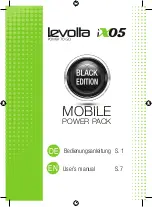
7
For tool with shallow bit hole
For tool with deep bit hole
1.
To install the bit, pull the sleeve in the direction of the
arrow and insert the bit into the sleeve as far as it will
go. Then release the sleeve to secure the bit.
(Fig. 7)
2.
To install the bit, pull the sleeve in the direction of the
arrow and insert the bit-piece and bit into the sleeve
as far as it will go. The bit-piece should be inserted
into the sleeve with its pointed end facing in. Then
release the sleeve to secure the bit.
(Fig. 8)
To remove the bit, pull the sleeve in the direction of the
arrow and pull the bit out firmly.
NOTE:
• If the bit is not inserted deep enough into the sleeve,
the sleeve will not return to its original position and the
bit will not be secured. In this case, try re-inserting the
bit according to the instructions above.
Hook (Fig. 9)
The hook is convenient for temporarily hanging the tool.
This can be installed on either side of the tool.
To install the hook, insert it into a groove in the tool hous-
ing on either side and then secure it with a screw. To
remove, loosen the screw and then take it out.
OPERATION
CAUTION:
• Never obstruct the air vents on the side of the tool for
cooling down oil unit and motor during operation. Fail-
ure to do so may cause the tool excessive hotness and
damage.
(Fig. 10)
The proper fastening torque may differ depending upon
the kind or size of the screw/bolt, the material of the
workpiece to be fastened, etc. The relation between fas-
tening torque and fastening time is shown in the figures.
(Fig. 11 & 12)
Hold the tool firmly and place the point of the driver bit in
the screw head. Apply forward pressure to the tool to the
extent that the bit will not slip off the screw and turn the
tool on to start operation.
NOTE:
• Use the proper bit for the head of the screw/bolt that
you wish to use.
• When fastening screw M8 or smaller, carefully adjust
pressure on the switch trigger so that the screw is not
damaged.
• Hold the tool pointed straight at the screw.
• If you tighten the screw for a time longer than shown in
the figures, the screw or the point of the driver bit may
be overstressed, stripped, damaged, etc. Before start-
ing your job, always perform a test operation to deter-
mine the proper fastening time for your screw.
• The fastening torque differs according to the increase
in the tool hotness.
• When driving wood screws, predrill pilot holes with
diameter smaller than the wood screws to make driving
easier and to prevent splitting of the workpiece.
• The diameter of wood screws that are within the tool
capacity is not always the same and depends on the
kind of material to be driven on. Make trial driving with
several screws before actual operation.
The fastening torque is affected by a wide variety of fac-
tors including the following. After fastening, always check
the torque with a torque wrench.
1.
When the battery cartridge is discharged almost
completely, voltage will drop and the fastening
torque will be reduced.
2.
Driver bit or socket bit
Failure to use the correct size driver bit or socket bit
will cause a reduction in the fastening torque.
3.
Bolt
• Even though the torque coefficient and the class of
bolt are the same, the proper fastening torque will
differ according to the diameter of bolt.
• Even though the diameters of bolts are the same,
the proper fastening torque will differ according to
the torque coefficient, the class of bolt and the bolt
length.
4.
The manner of holding the tool or the material of
driving position to be fastened will affect the torque.
5.
Operating the tool at low speed will cause a reduc-
tion in the fastening torque.
MAINTENANCE
CAUTION:
• Always be sure that the tool is switched off and the bat-
tery cartridge is removed before attempting to perform
inspection or maintenance.
• Never use gasoline, benzine, thinner, alcohol or the
like. Discoloration, deformation or cracks may result.
Replacing carbon brushes
Replace when they wear down to the limit mark. Keep
the carbon brushes clean and free to slip in the holders.
Both carbon brushes should be replaced at the same
time. Use only identical carbon brushes.
(Fig. 13)
Use a screwdriver to remove two screws then remove the
rear cover.
(Fig. 14)
Raise the arm part of the spring and then place it in the
recessed part of the housing with a slotted bit screw-
driver of slender shaft or the like.
(Fig. 15)
Use pliers to remove the carbon brush cap of the carbon
brushes. Take out the worn carbon brushes, insert the
new ones and replace the carbon brush cap in reverse.
(Fig. 16)
Make sure that the carbon brush cap have fit into the
holes in brush holders securely.
(Fig. 17)
Reinstall the rear cover and tighten two screws securely.
To maintain product SAFETY and RELIABILITY, repairs,
any other maintenance or adjustment should be per-
formed by Makita Authorized Service Centers, always
using Makita replacement parts.
A = 12 mm
B = 9 mm
Use only these type of bit. Follow the
procedure (1).
(Note) Bit-piece is not necessary.
A = 17 mm
B = 14 mm
To install these types of bits, follow the
procedure (1).
A = 12 mm
B = 9 mm
To install these types of bits, follow the
procedure (2).
(Note) Bit-piece is necessary for
installing the bit.
Содержание DTS130ZJ
Страница 4: ...4 17 28 27 006304 ...
Страница 46: ...46 ...
Страница 47: ...47 ...
Страница 48: ...Makita Corporation Anjo Aichi Japan www makita com 885322 994 IDE ...








































